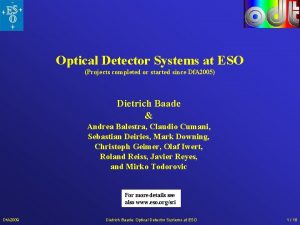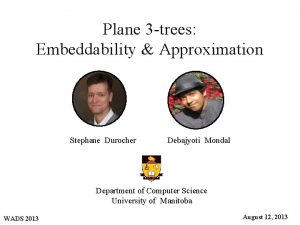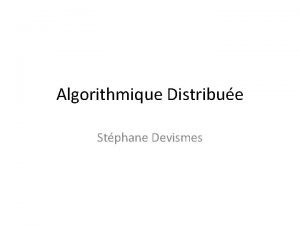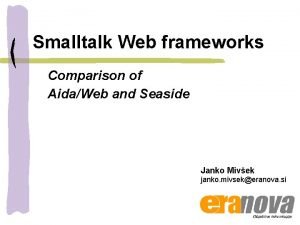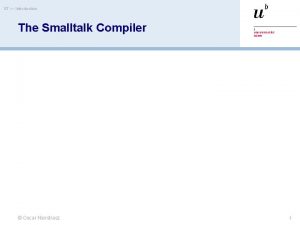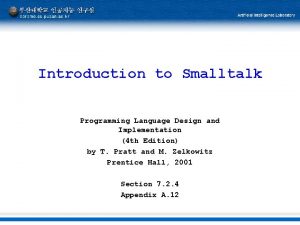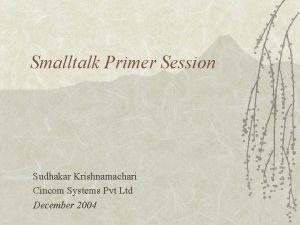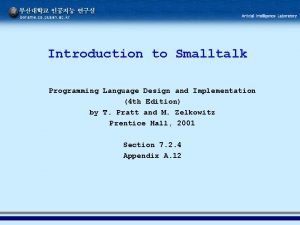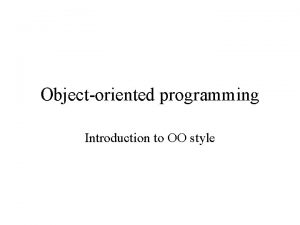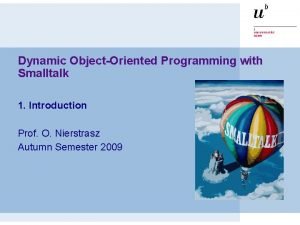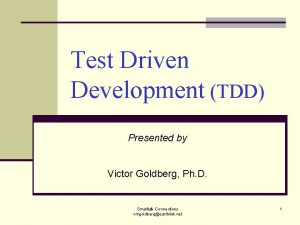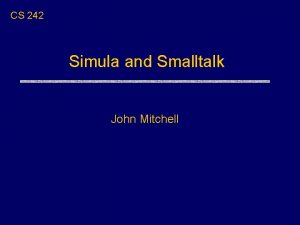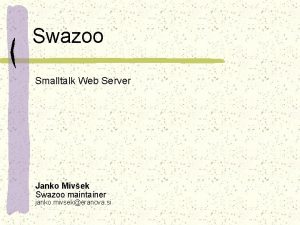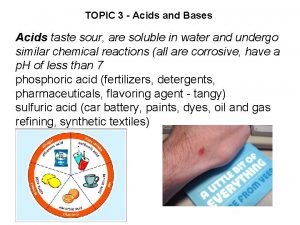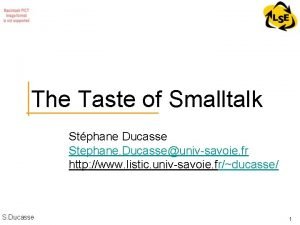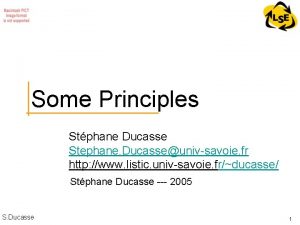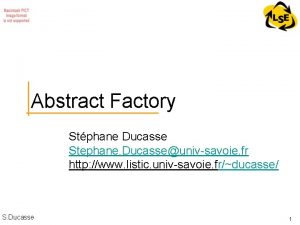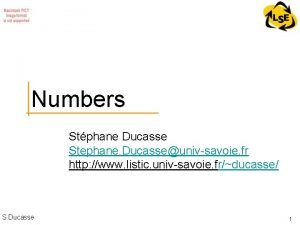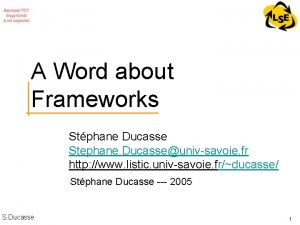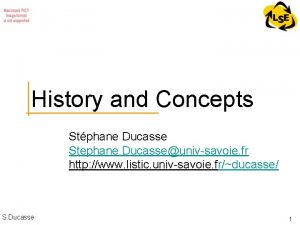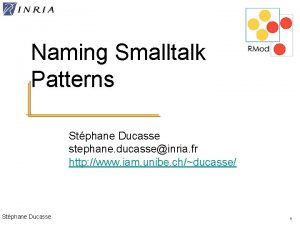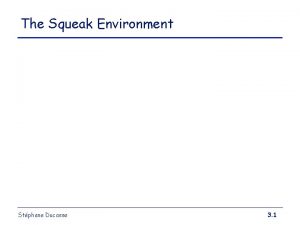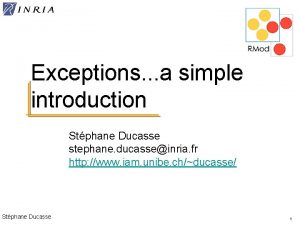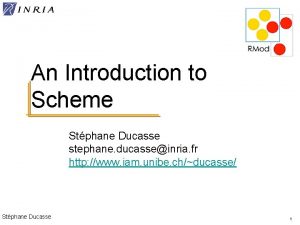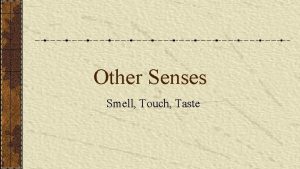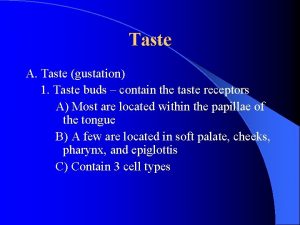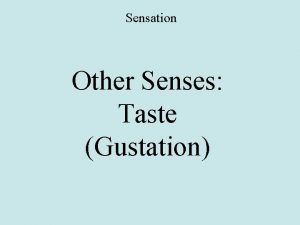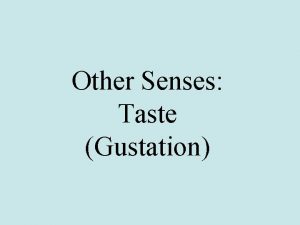A Taste of Smalltalk Stphane Ducasse Stephane Ducasseunivsavoie



































- Slides: 35

A Taste of Smalltalk Stéphane Ducasse Stephane. Ducasse@univ-savoie. fr http: //www. listic. univ-savoie. fr/~ducasse/ S. Ducasse 1

License: CC-Attribution-Share. Alike 2. 0 http: //creativecommons. org/licenses/by-sa/2. 0/ S. Ducasse 2

Goals • • S. Ducasse Two examples: • • ‘hello world’ A tamagotchi To give you an idea of: • • • the syntax the elementary objects and classes the environment 3

An Advice You do not have to know everything!!! • “Try not to care - Beginning Smalltalk programmers often have trouble because they think they need to understand all the details of how a thing works before they can use it. This means it takes quite a while before they can master Transcript show: ‘Hello World’. One of the great leaps in OO is to be able to answer the question "How does this work? " with "I don’t care"“. Alan Knight. Smalltalk Guru • We will show you how to learn and find your way S. Ducasse 4

Some Conventions • Return Values 1 + 3 -> 4 Node new -> a. Node • • • Method selector #add: Method scope conventions Instance Method defined in class Node: Node>>accept: a. Packet • Class Method defined in class Node (in the class of the class Node) Node class>>with. Name: a. Symbol • a. Something is an instance of the class Something S. Ducasse 5

Roadmap • “hello world” • Syntax • a tamagotchi S. Ducasse 6

Hello World • Transcript show: ‘hello world’ • At anytime we can dynamically ask the system to evaluate an expression. To evaluate an expression, select it and with the middle mouse button apply do. It. Transcript is a special object that is a kind of standard output. It refers to a Text. Collector instance associated with the launcher. • • • In Squeak Transcript is dead slow. . . S. Ducasse 7

Transcript show: ‘hello world’ S. Ducasse 8

Everything is an Object – – – The workspace is an object. The window is an object: it is an instance of System. Window. The text editor is an object: it is an instance of Paragraph. Editor. The scrollbars are objects too. ‘hello word’ is an object: it is a. String instance of String. #show: is a Symbol that is also an object. The mouse is an object. The parser is an object: instance of Parser. The compiler is also an object: instance of Compiler. The process scheduler is also an object. The garbage collector is an object: instance of Object. Memory. Smalltalk is a consistent, uniform world written in itself. You can learn how it is implemented, you can extend it or even modify it. All the code is available and readable S. Ducasse 9

Smalltalk Object Model • ***Everything*** is an object ⇒ Only message passing ⇒ Only late binding • • • Instance variables are private to the object Methods are public Everything is a pointer Garbage collector Single inheritance between classes Only message passing between objects S. Ducasse 10

Roadmap • • • S. Ducasse Hello World First look at the syntax a Tamagotchi 11

Power & Simplicity: The Syntax on a Post. Card example. With. Number: x “A method that illustrates every part of Smalltalk method syntax except primitives. It has unary, binary, and key word messages, declares arguments and temporaries (but not block temporaries), accesses a global variable (but not and instance variable), uses literals (array, character, symbol, string, integer, float), uses the pseudo variable true false, nil, self, and super, and has sequence, assignment, return and cascade. It has both zero argument and one argument blocks. It doesn’t do anything useful, though” |y| true & false not & (nil is. Nil) if. False: [self halt]. y : = self size + super size. #($a #a ‘a’ 1 1. 0) do: [: each | Transcript show: (each class name); show: (each print. String); show: ‘ ‘]. ^x<y S. Ducasse 12

Yes if. True: is sent to a boolean Weather is. Raining if. True: [self take. My. Umbrella] if. False: [self take. My. Sunglasses] if. True: if. False is sent to an object: a boolean! S. Ducasse 13

Yes a collection is iterating on itself #(1 2 -4 -86) do: [: each | Transcript show: each abs print. String ; cr ] >1 >2 >4 > 86 Yes we ask the collection object to perform the loop on itself S. Ducasse 14

Do. It, Print. It, Inspect. It and Accept • Accept = Compile: Accept a method or a class • • • definition Do. It = send a message to an object Print. It = send a message to an object + print the result (#print. On: ) Inspect. It = send a message to an object + inspect the result (#inspect) S. Ducasse 15

Objects send messages • • S. Ducasse Transcript show: ‘hello world’ The above expression is a message • • the object Transcript is the receiver of the message the selector of the message is #show: one argument: a string ‘hello world’ Transcript is a global variable (starts with an uppercase letter) that refers to the Launcher’s report part. 16

Vocabulary Point Message passing or sending a message is equivalent to invoking a method in Java or C++ calling a procedure in procedural languages applying a function in functional languages of course the last two points must be considered under the light of polymorphism S. Ducasse 17

Roadmap • • • S. Ducasse Hello World First look at the syntax A tamagotchi 18

Tamagotchi • Small entity S. Ducasse – Its own night and day cycle – Eating, sleeping, been hungry, been satisfied – Changing color to indicate its mood 19

Tomagotchi sleeping day wake. Up night fall. Asleep woken up is. Hungry is. Satisfied hungry eat satisfied S. Ducasse 20

Instantiating… • • To create a tomagoshi: Tomagoshi new. Stand. Alone open. In. World S. Ducasse 21

How to Define a Class (Sq) • Fill the template: Name. Of. Superclass subclass: #Name. Of. Class instance. Variable. Names: 'inst. Var. Name 1' class. Variable. Names: 'Class. Var. Name 1 Class. Var. Name 2' pool. Dictionaries: '' category: ’category name' S. Ducasse 22

Tomagoshi (Sq) • For example to create the class Tomagoshi Morph subclass: #Tomagoshi instance. Variable. Names: ‘tummy hunger day. Count is. Night' class. Variable. Names: '' pool. Dictionaries: '' category: ’TOMA' S. Ducasse 23

Class Comment! • I represent a tomagoshi. A small virtual animal that have its own life. • day. Count <Number> represents the number of hour (or tick) in my day and night. is. Night <Boolean> represents the fact that this is the night. tummy <Number> represents the number of times you feed me by clicking on me. hunger <Number> represents my appetite power. I will be hungry if you do not feed me enough, but I'm selfish so as soon as I' satisfied I fall asleep because I do not have a lot to say. • • S. Ducasse 24

How to define a method? message selector and argument names "comment stating purpose of message" | temporary variable names | statements Tomagoshi>>initialize. To. Stand. Alone “Initialize the internal state of a newly created tomagoshi” super initialize. To. Stand. Alone. tummy : = 0. hunger : = 2 at. Random + 1. self day. Start. self wake. Up S. Ducasse 25

Initializing Tomagoshi>>initialize. To. Stand. Alone “Initialize the internal state of a newly created tomagoshi” super initialize. To. Stand. Alone. tummy : = 0. hunger : = 2 at. Random + 1. self day. Start. self wake. Up S. Ducasse 26

day. Start Tomagoshi>>day. Start night : = false. day. Count : = 10 S. Ducasse 27

Step step “This method is called by the system at regurlar time interval. It defines the tomagoshi behavior. ” self time. Pass. self is. Hungry if. True: [self color: Color red]. self is. Satisfied if. True: [self color: Color blue. self fall. Asleep]. self is. Night if. True: [self color: Color black. self fall. Asleep] S. Ducasse 28

Time Pass Tomagoshi>>time. Pass "Manage the night and day alternance" Smalltalk beep. day. Count : = day. Count -1. day. Count is. Zero if. True: [ self night. Or. Day. End. day. Count : = 10]. self digest Tomagoshi>>night. Or. Day. End "alternate night and day" night : = night not S. Ducasse 29

Digest Tomagoshi>>digest "Digest slowly: every two cycle, remove one from the tummy” (day. Count is. Divisible. By: 2) if. True: [ tummy : = tummy -1] S. Ducasse 30

Testing Tomagoshi>>is. Hungry ^ hunger > tummy Tomagoshi>>is. Satisfied ^self is. Hungry not Tomagoshi>>is. Night ^ night S. Ducasse 31

State Tomagoshi>>wake. Up self color: Color green. state : = self wake. Up. State Tomagoshi>>wake. Up. State "Return how we codify the fact that I sleep" ^ #sleep Tomagoshi>> is. Sleeping ^ state = self wake. Up. State S. Ducasse 32

Eating Tomagoshi>>eat tummy : = tummy + 1 S. Ducasse 33

Time and Events Tomagoshi>>step. Time "The step method is executed every stepping. Time ms" ^ 500 Tomagoshi>>handles. Mouse. Down: evt "true means that the morph can react when the mouse down over it" ^ true Tomagoshi>>mouse. Down: evt self eat S. Ducasse 34

Summary What is a message? What is the message receiver? What is the method selector? How to create a class? How to define a method? S. Ducasse 35
 Stephane gallardo
Stephane gallardo Stephane guisard
Stephane guisard Stephane adam facebook
Stephane adam facebook Stephane j. durocher
Stephane j. durocher Stephane mancini
Stephane mancini Stephane compertz
Stephane compertz Stephane bringuier
Stephane bringuier Ron
Ron Ent stephane hessel
Ent stephane hessel Stephane ouaki
Stephane ouaki Stéphane devismes
Stéphane devismes Docteur didelot montpellier
Docteur didelot montpellier Stephane bucaille
Stephane bucaille Smalltalk seaside
Smalltalk seaside Seaside smalltalk
Seaside smalltalk Sma compiler
Sma compiler Squeak smalltalk tutorial
Squeak smalltalk tutorial Modern smalltalk
Modern smalltalk Smalltalk designed by
Smalltalk designed by Smalltalk
Smalltalk Small talk programming language examples
Small talk programming language examples Smalltalk history
Smalltalk history Oo style
Oo style Visual age smalltalk
Visual age smalltalk Seaside now and then
Seaside now and then Cincom smalltalk
Cincom smalltalk Modern smalltalk
Modern smalltalk Smalltalk
Smalltalk Themen smalltalk
Themen smalltalk Smalltalk seaside
Smalltalk seaside Smalltalk web framework
Smalltalk web framework Bases taste sour
Bases taste sour Acids are ____to taste
Acids are ____to taste Bitter vs sour
Bitter vs sour Yogurt taste
Yogurt taste Palillae
Palillae

